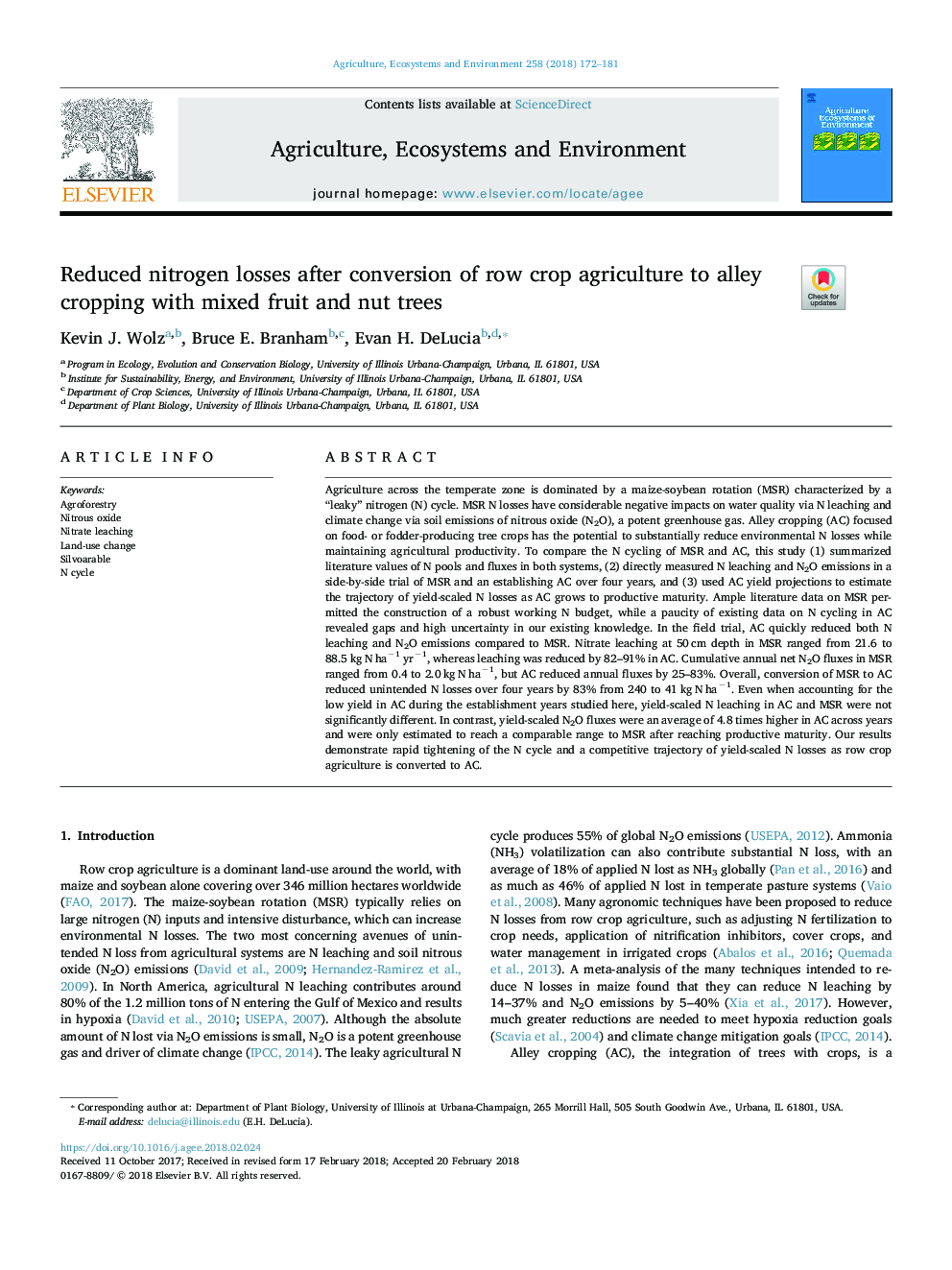| کد مقاله | کد نشریه | سال انتشار | مقاله انگلیسی | نسخه تمام متن |
|---|---|---|---|---|
| 8487127 | 1551994 | 2018 | 10 صفحه PDF | دانلود رایگان |
عنوان انگلیسی مقاله ISI
Reduced nitrogen losses after conversion of row crop agriculture to alley cropping with mixed fruit and nut trees
ترجمه فارسی عنوان
کاهش تلفات نیتروژن پس از تبدیل کشاورزی ردیف به کشت کوسه با درختان میوه و درخت نارنجی
دانلود مقاله + سفارش ترجمه
دانلود مقاله ISI انگلیسی
رایگان برای ایرانیان
کلمات کلیدی
موضوعات مرتبط
علوم زیستی و بیوفناوری
علوم کشاورزی و بیولوژیک
علوم زراعت و اصلاح نباتات
چکیده انگلیسی
Agriculture across the temperate zone is dominated by a maize-soybean rotation (MSR) characterized by a “leaky” nitrogen (N) cycle. MSR N losses have considerable negative impacts on water quality via N leaching and climate change via soil emissions of nitrous oxide (N2O), a potent greenhouse gas. Alley cropping (AC) focused on food- or fodder-producing tree crops has the potential to substantially reduce environmental N losses while maintaining agricultural productivity. To compare the N cycling of MSR and AC, this study (1) summarized literature values of N pools and fluxes in both systems, (2) directly measured N leaching and N2O emissions in a side-by-side trial of MSR and an establishing AC over four years, and (3) used AC yield projections to estimate the trajectory of yield-scaled N losses as AC grows to productive maturity. Ample literature data on MSR permitted the construction of a robust working N budget, while a paucity of existing data on N cycling in AC revealed gaps and high uncertainty in our existing knowledge. In the field trial, AC quickly reduced both N leaching and N2O emissions compared to MSR. Nitrate leaching at 50â¯cm depth in MSR ranged from 21.6 to 88.5â¯kgâ¯Nâ¯haâ1â¯yrâ1, whereas leaching was reduced by 82-91% in AC. Cumulative annual net N2O fluxes in MSR ranged from 0.4 to 2.0â¯kgâ¯Nâ¯haâ1, but AC reduced annual fluxes by 25-83%. Overall, conversion of MSR to AC reduced unintended N losses over four years by 83% from 240 to 41â¯kgâ¯Nâ¯haâ1. Even when accounting for the low yield in AC during the establishment years studied here, yield-scaled N leaching in AC and MSR were not significantly different. In contrast, yield-scaled N2O fluxes were an average of 4.8 times higher in AC across years and were only estimated to reach a comparable range to MSR after reaching productive maturity. Our results demonstrate rapid tightening of the N cycle and a competitive trajectory of yield-scaled N losses as row crop agriculture is converted to AC.
ناشر
Database: Elsevier - ScienceDirect (ساینس دایرکت)
Journal: Agriculture, Ecosystems & Environment - Volume 258, 15 April 2018, Pages 172-181
Journal: Agriculture, Ecosystems & Environment - Volume 258, 15 April 2018, Pages 172-181
نویسندگان
Kevin J. Wolz, Bruce E. Branham, Evan H. DeLucia,
